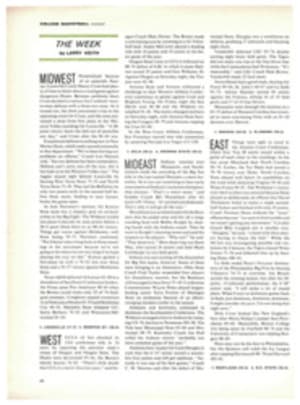
WHEN YOU'RE IN, YOU CAN'T BE TOO FAR OUT OF IT
He felt the frightening brush of the crossbar against his belly as he pushed the pole away and, falling, watched the bar tremble as he landed in the pit.
It held and he jumped up, hands clenched into fists. He bounded out of the foam rubber, and his brother and his girl came running across the track and hugged him. He lifted the girl and carried her around the arena. And all the spectators could read the joy on his face and the happiness, confusion and just a touch of fear on hers.
That was Don Bragg in 1959, breaking the indoor record for the pole vault. He did it in Philadelphia, and the 10,000 people watching were joyful with him, because in indoor track the performances go on virtually in the laps of the spectators. They can see and feel almost every effort and reaction that the athlete displays before, during and after the competition.
Outdoors, some events—the high jump, the javelin, the discus, for example—are almost ignored because of the distances between them and the stands. And the tension that develops during races inevitably slackens when the runners are on the far side of the track. Indoors, the emotion is always immediate.
It was there one night in a tall, thin, high school miler, a nobody, waiting for the starter's gun and trying to control a twitching leg, holding it still with both hands until the start. Running, the leg was no problem. Late in the race, trailing by a considerable margin, the boy sprinted the last two laps, caught the leaders at the tape and cried without shame.
It was there in Glenn Cunningham, the barrel-chested Kansan who dominated the mile 40 years ago. You could almost feel Cunningham's confidence as he briskly followed the pace, waiting for the precise moment to unleash his devastating sprint. It was there in the late '60s and early '70s when slender Martin McGrady, a superlative runner indoors who was never very successful outside, dueled on the boards in the 600 with the burly, aggressive Lee Evans, the Olympic 400-meter champion—a rapier challenging a saber.
If the crowd reacts to the tension, it also contributes to it. Since the fans are closer to the athlete, the athlete is closer to the fans, too, and he hears them and reacts to them. Steve Smith, the professional pole vaulter who has gone higher indoors than anyone else, amateur or pro, is visibly inspired by the excitement and anticipation of his audience. Kip Keino, the superb Kenyan runner, used to toss his cap to the spectators. "I have to thank the people," a winner will say. "They really fired me up." And a loser will mutter, "Damn crowd."
The indoor crowd appreciates the subtleties, the tactical drift to the outside down the straightaway to force a challenging opponent wide, the feigned indifference of one high jumper to the best efforts of his chief rival. The competition, the conflict, the tension are almost palpable.
And the splendid thing is, the spectators are aware of it. But, then, indoor track is an aware sport.

